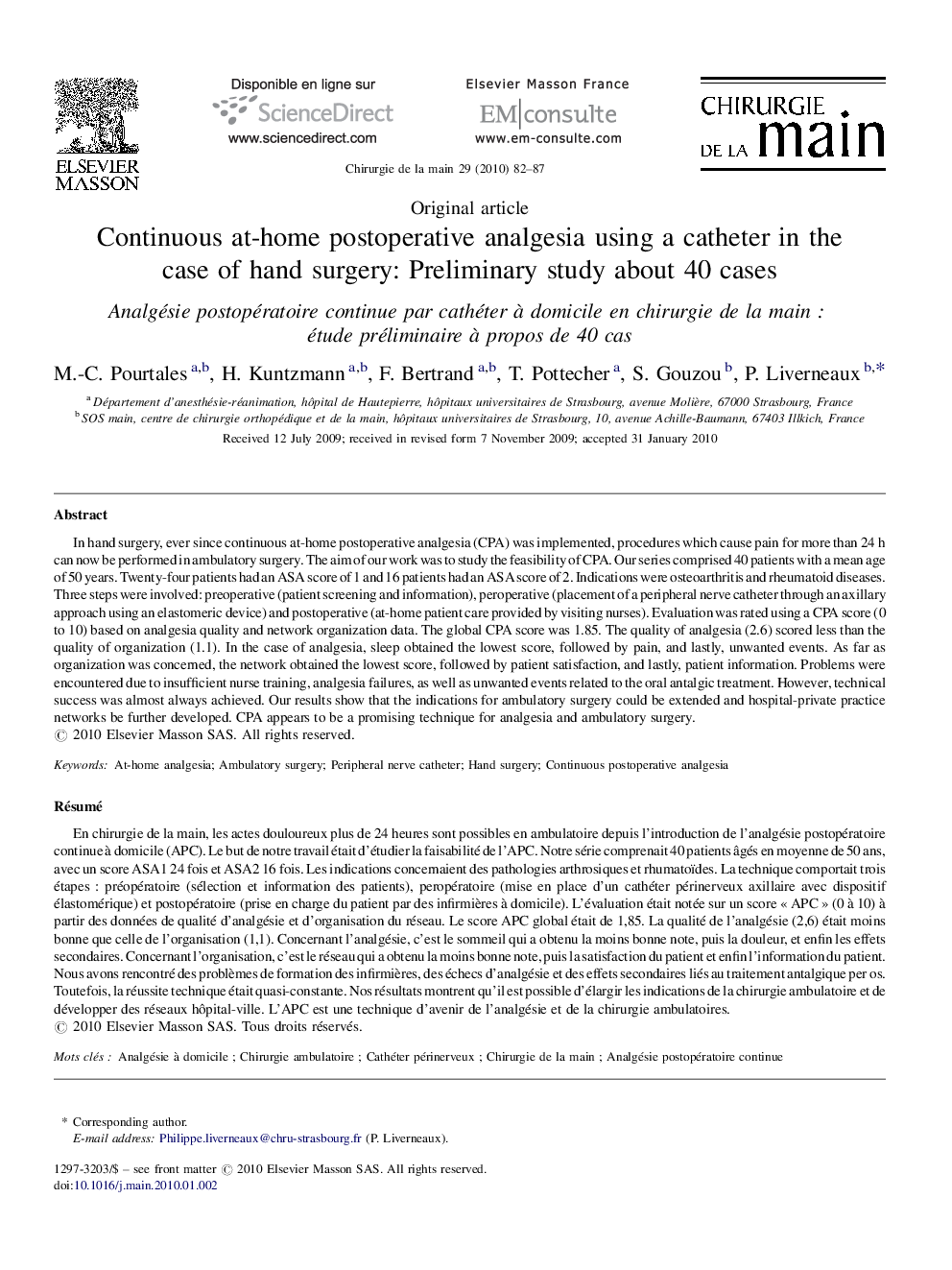| کد مقاله | کد نشریه | سال انتشار | مقاله انگلیسی | نسخه تمام متن |
|---|---|---|---|---|
| 4049482 | 1264835 | 2010 | 6 صفحه PDF | دانلود رایگان |

In hand surgery, ever since continuous at-home postoperative analgesia (CPA) was implemented, procedures which cause pain for more than 24 h can now be performed in ambulatory surgery. The aim of our work was to study the feasibility of CPA. Our series comprised 40 patients with a mean age of 50 years. Twenty-four patients had an ASA score of 1 and 16 patients had an ASA score of 2. Indications were osteoarthritis and rheumatoid diseases. Three steps were involved: preoperative (patient screening and information), peroperative (placement of a peripheral nerve catheter through an axillary approach using an elastomeric device) and postoperative (at-home patient care provided by visiting nurses). Evaluation was rated using a CPA score (0 to 10) based on analgesia quality and network organization data. The global CPA score was 1.85. The quality of analgesia (2.6) scored less than the quality of organization (1.1). In the case of analgesia, sleep obtained the lowest score, followed by pain, and lastly, unwanted events. As far as organization was concerned, the network obtained the lowest score, followed by patient satisfaction, and lastly, patient information. Problems were encountered due to insufficient nurse training, analgesia failures, as well as unwanted events related to the oral antalgic treatment. However, technical success was almost always achieved. Our results show that the indications for ambulatory surgery could be extended and hospital-private practice networks be further developed. CPA appears to be a promising technique for analgesia and ambulatory surgery.
RésuméEn chirurgie de la main, les actes douloureux plus de 24 heures sont possibles en ambulatoire depuis l’introduction de l’analgésie postopératoire continue à domicile (APC). Le but de notre travail était d’étudier la faisabilité de l’APC. Notre série comprenait 40 patients âgés en moyenne de 50 ans, avec un score ASA1 24 fois et ASA2 16 fois. Les indications concernaient des pathologies arthrosiques et rhumatoïdes. La technique comportait trois étapes : préopératoire (sélection et information des patients), peropératoire (mise en place d’un cathéter périnerveux axillaire avec dispositif élastomérique) et postopératoire (prise en charge du patient par des infirmières à domicile). L’évaluation était notée sur un score « APC » (0 à 10) à partir des données de qualité d’analgésie et d’organisation du réseau. Le score APC global était de 1,85. La qualité de l’analgésie (2,6) était moins bonne que celle de l’organisation (1,1). Concernant l’analgésie, c’est le sommeil qui a obtenu la moins bonne note, puis la douleur, et enfin les effets secondaires. Concernant l’organisation, c’est le réseau qui a obtenu la moins bonne note, puis la satisfaction du patient et enfin l’information du patient. Nous avons rencontré des problèmes de formation des infirmières, des échecs d’analgésie et des effets secondaires liés au traitement antalgique per os. Toutefois, la réussite technique était quasi-constante. Nos résultats montrent qu’il est possible d’élargir les indications de la chirurgie ambulatoire et de développer des réseaux hôpital-ville. L’APC est une technique d’avenir de l’analgésie et de la chirurgie ambulatoires.
Journal: Chirurgie de la Main - Volume 29, Issue 2, April 2010, Pages 82–87